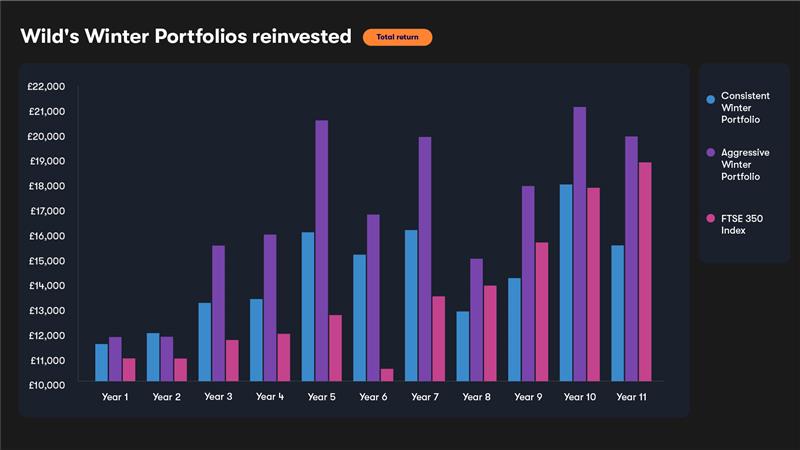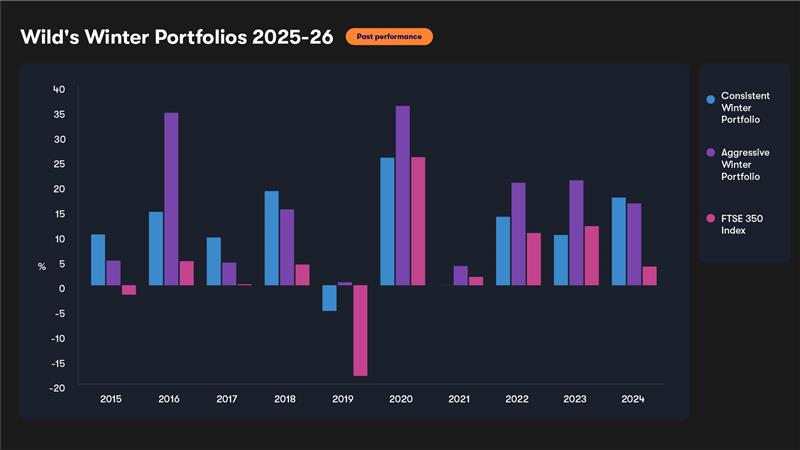Wild’s Winter Portfolios 2025-26: a return to form?
After back-to-back double-digit gains for Wild’s Winter Portfolios, last year’s six-month strategy was more difficult. Lee Wild explains what happened and talks through the new portfolio’s track record.
23rd October 2025 10:18
by Lee Wild from interactive investor

This time last year I wrote that while stock markets were volatile, the trend was positive. US indices made a string of record highs, joined eventually by our own FTSE 100. But April’s spike in volatility to levels rarely seen since the financial crisis 17 years ago, was a reminder that politics and macro events have the power to seriously disrupt long-term established trends and anomalies.
- Invest with ii: SIPP Account | Stocks & Shares ISA | See all Investment Accounts
It was such events that ended a two-year winning streak for Wild’s Winter Portfolios. Average total returns of 18.7% and 18.8% for the consistent and aggressive portfolios, respectively, throughout 2022 and 2023 compared with a more modest 13.4% for the benchmark FTSE 350 index.
As I said in my post-winter summary in May, I can’t blame the UK Budget or even President Donald Trump’s tariff policies, it was just a poor year for certain stocks which, on paper, really should have done much better. Some share price rallies just ran out of steam, other constituents had sped higher ahead of the winter portfolio launch, while a takeover came too late to save Spectris from winning the wooden spoon.
When the dust had settled, Wild’s Consistent Winter Portfolio 2024-25, made up of the five FTSE 350 companies that have risen the most winters (1 November to 30 April) over the past decade, was down 14.4%, or 13.7% when you include dividend income. Wild’s Aggressive Winter Portfolio, where constituents must have risen at least 80% of winters over the past decade, fell 6.7%, or 5.7% with dividend income. The FTSE 350 index rose by 3.8% and 5.8% respectively.
While we all try to avoid investment losses, they are unfortunately inevitable. And this is only the third negative winter performance in the 11 years we’ve run the portfolios. Reinvesting proceeds from the first winter portfolio in 2014 into the 2015 edition and so on would have almost doubled the money of “aggressive” investors (+99.3%). The same tactic for the consistent portfolio would have returned 55.1%. For the FTSE 350, its 88.8%. You can see the results in the chart below:

Source: interactive investor. Shows £10,000 invested in the first winter portfolio (2014-15) with original stake and proceeds reinvested into the following year’s portfolio, and so on. Consistent Winter Portfolio has generated a total return of 55.1% and Aggressive portfolio 99.3%. Benchmark FTSE 350 index is up 88.8%. Winter portfolios and FTSE 350 include dividends but not buying/selling fees or stamp duty. Past performance is no guide to future performance. Investments and the income from them can go down as well as up and you may not get back the original investment.
How we do it
The objective is to create two portfolios that best exploit stock market seasonality. These are data-driven portfolios, so there is no manual intervention.
Screening only stocks listed in the FTSE 350 index for a greater level of liquidity, the five most reliable winter performers of the past 10 years make up Wild’s Consistent Winter Portfolio. A basket of five higher-risk/higher-return stocks which still exhibit impressive consistency over the winter months become Wild’s Aggressive Winter Portfolio.
All five stocks in Wild’s Consistent Winter Portfolio 2025-26 have each risen in nine of the previous 10 winters. The average return between November and April over the past decade, excluding dividends, is 11.7% versus an average gain of just 4.3% for the FTSE 350 benchmark index.
To access even greater potential returns, we relax the entry criteria for the aggressive portfolio for 2025-26. That makes it a little riskier, but even now it also has one stock with a 90% winter win rate and four with eight positive winters out of the past 10. The average winter return for the 2025-26 aggressive portfolio since 2015 is 16.0%.

Source: interactive investor and Stephen Eckett. Shows performance of stocks included in the 2025-26 winter portfolios had they been owned for the 10 years between 2015 and 2024, and for the FTSE 350 benchmark index over the same period. Performance is between 1 November and 30 April. Past performance is no guide to future performance. Investments and the income from them can go down as well as up and you may not get back the original investment.
What we want to hear is that stocks underperform during the summer and outperform in the winter months; that’s what this trading strategy is all about. Last year, stocks had a strong summer, including constituents of both our portfolios. That meant share prices were already factoring in a lot of good news, robbing us of potential winter gains.
It’s not too dissimilar this time, with three portfolio companies having achieved double-digit gains over the summer months so far (30 April to 22 October). The FTSE 350 index is up 12%. Three portfolio constituents are currently registering summer losses.
The five stocks in each of the 2025-26 winter portfolios will be announced on Friday 31 October.
The rationale
Our interest was originally piqued by an anomaly in the stock market which demonstrates that buying and selling at two specific dates of the year has historically generated better returns than if you had stayed invested all year round.
Buying a portfolio of shares on 1 November, or late on 31 October, and selling them on 30 April the following year, has significantly outperformed the wider stock market over more than a quarter of a century. It provides investors with a clear strategy that’s simple to execute and enjoys a successful performance history.
- Britain’s biggest IPO of 2025: what you need to know
- Could this risky approach solve the UK’s productivity puzzle?
Data provided by Stephen Eckett, mathematician and co-founder of Harriman House, publisher of The UK Stock Market Almanac, shows that £100 invested in the UK stock market (as measured by the FTSE All-Share Index) in 1994 and held continuously for the past 31 years, would have grown to £291 (excluding dividends). However, if they had only invested in the market between 1 November and 30 April every year, then that £100 would be worth £458. Conversely, if they had chosen to invest only over the summer months, they would have lost money; their original £100 would be worth just £58.
“This anomaly, sometimes called the Sell in May Effect, describes the tendency of equities to perform better in the winter (November to April) than the summer (May to October). And this anomaly has been known about for a long time,” explains Eckett, “there is even some evidence that dates knowledge of this effect back to 1694.
“In recent years, political and economic turmoil has disrupted certain long-established trends and anomalies. For example, in 2020 the Sell in May Effect was contradicted by the large sell-off in equities seen in February and March that year. However, in the five years since then the Sell in May Effect has strongly re-asserted itself, with the index in the winter outperforming that in the summer every year.”
Why does the winter portfolio strategy work?
No conclusive studies neatly explain the historic outperformance of stock markets during the winter months, but there are plenty of theories, some more plausible than others.
Perhaps most likely is that far more money flows into the market over the winter months. This typically happens when big players at financial institutions on Wall Street and the Square Mile return from their summer breaks. The City doesn’t shut down these days for the cricket, horse racing and rowing at Henley, but plenty of decision makers are out of the office on holiday, so it is probable that some of the big trading decisions are left until everyone is back in the office. Investment strategies deployed in the following months increase liquidity and boost sentiment.
Most investors will have heard of the Santa rally, when equity markets historically have done well in the weeks leading up to Christmas. You could attribute this to seasonal optimism, or, more likely, end of calendar-year window dressing of portfolios by funds and investment houses. Selling losers and buying successful stocks flatters the numbers that determine City bonuses.
Then, in the spring, at the end of the financial winter, investors take advantage of tax-efficient products in the run up to tax year-end. In what is often referred to as ISA season, many investors rush to use their tax-free allowance in the final days, weeks and months of the tax year. So-called early birds then use their ISA allowance as soon as the new tax year begins.
Events to monitor over the next six months
One of the biggest enemies of the winter portfolios is a strong summer for stocks. It doesn’t often happen, but when it does it can reduce the size of winter profits and increase the odds of losses. As I mentioned earlier, since 30 April this year the FTSE 350 is up 12%. What’s more, the market remains nervous, with talk of a correction at some point. That may be wide of the mark, and there are plenty of reasons to be optimistic about stocks, but, as always, there are any number of events, both global and domestic, that will likely affect the direction of financial markets in the months ahead.
By the time the winter portfolios launch, one hopes that US politicians will have done a deal to end the government shutdown there. If it hasn’t, we’re in trouble. President Trump and Chinese leader Xi Jinping are soon to meet in South Korea, and there must surely be some kind of resolution to the trade dispute and punitive tariffs. Again, failure to reach agreement will be problematic.
High interest rates, stubbornly high inflation, a weaker jobs market and modest economic growth are issues that plague many developed nations currently. Lower borrowing costs seem inevitable, but it’s a balancing act that both politicians and policymakers must get right. What is certain, is that central bankers will remain very much under the spotlight.
- The Autumn Budget 2025: just how painful could it be?
- Sign up to our free newsletter for investment ideas, latest news and award-winning analysis
UK politicians have the power to upend markets too, and the Autumn Budget on 26 November is the perfect opportunity. The Labour government’s £22 billion black hole is more like a £50 billion funding deficit, according to the National Institute of Economic and Social Research (NIESR). It’s not clear where the money will come from, but the size of the shortfall means Chancellor Rachel Reeves must make some tough decisions. She will not be able to please everybody.
And it’s easy to forget that there’s a war still raging in Ukraine, a conflict that will reach its fourth anniversary at the end of February next year. It is perhaps distasteful, but defence stocks have been beneficiaries, and European leaders bullied by President Trump into promising a significant increase in defence spending.
Major world events can and will affect market direction over the next six months. We’ll have to wait and see which way. All we can do is believe in the market anomaly that shows, historically, that stocks generate their best stock over the winter months. We’re hoping that last year’s performance was just a blip, and that Wild’s Winter Portfolios will return to winning ways in 2025-26.
These articles are provided for information purposes only. Occasionally, an opinion about whether to buy or sell a specific investment may be provided by third parties. The content is not intended to be a personal recommendation to buy or sell any financial instrument or product, or to adopt any investment strategy as it is not provided based on an assessment of your investing knowledge and experience, your financial situation or your investment objectives. The value of your investments, and the income derived from them, may go down as well as up. You may not get back all the money that you invest. The investments referred to in this article may not be suitable for all investors, and if in doubt, an investor should seek advice from a qualified investment adviser.
Full performance can be found on the company or index summary page on the interactive investor website. Simply click on the company's or index name highlighted in the article.
Disclosure
We use a combination of fundamental and technical analysis in forming our view as to the valuation and prospects of an investment. Where relevant we have set out those particular matters we think are important in the above article, but further detail can be found here.
Please note that our article on this investment should not be considered to be a regular publication.
Details of all recommendations issued by ii during the previous 12-month period can be found here.
ii adheres to a strict code of conduct. Contributors may hold shares or have other interests in companies included in these portfolios, which could create a conflict of interests. Contributors intending to write about any financial instruments in which they have an interest are required to disclose such interest to ii and in the article itself. ii will at all times consider whether such interest impairs the objectivity of the recommendation.
In addition, individuals involved in the production of investment articles are subject to a personal account dealing restriction, which prevents them from placing a transaction in the specified instrument(s) for a period before and for five working days after such publication. This is to avoid personal interests conflicting with the interests of the recipients of those investment articles.